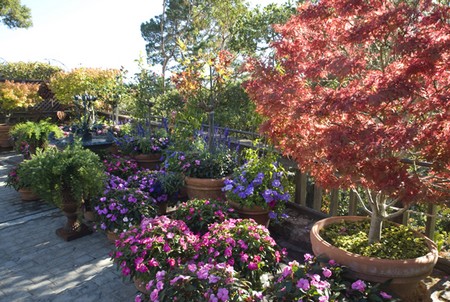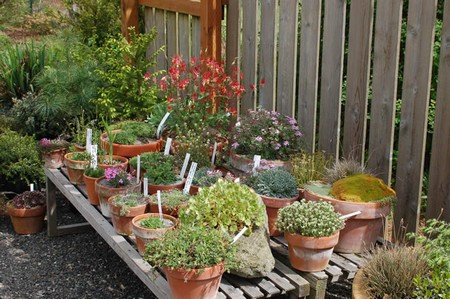When growing plants in tubs, urns, pots and similar containers, and in window boxes and hanging baskets, you should periodically give them a fresh supply of compost, for potting composts deteriorate eventually, with drainage and aeration becoming poor and plant foods depleted.
Potting on
Single plants are best started off in small containers and potted-on (or moved on) to containers two sizes larger before they become pot-bound (container packed with roots). This is better than putting a small plant in a very big container as then it will have a large volume of compost around its roots which may then remain very wet with possibility of root-rot. Of course, if you are starting off with a large plant then it would be more practical to give it a large final-size container to start with.

The best time of year for potting-on is in early spring and the technique is as described under Planting Techniques for single plants in containers.
Re-potting
Single permanent plants in large final tubs, pots, etc, should ideally be re-potted every other year to give them a fresh supply of compost. Again early spring is the best time.
It will take two people to handle a large plant. Firstly, the container should be placed on its side. Then one person taps the rim of the container with a block of wood. At the same time the second person gently and steadily pulls the plant. Hopefully the rootball should slide out. If it doesn’t insert a long thin blade all round the inside, between container wall and rootball. Then try again.
Reduce the soilball in size by carefully teasing away about 5 cm (2 in) of compost from the sides, bottom and top. If necessary roots can be pruned back by this amount. Then scrub out the container with water to remove all traces of compost and allow it to dry thoroughly. In the meantime keep the rootball of the plant covered with wet sacking to prevent drying out.
Finally replace the plant in its container, using new compost, which must be worked right down to the bottom. There should be no air spaces.
In the years between re-potting, or if you find you are unable to re-pot, topdressing can be carried out in spring. Remove about 2.5 cm (1 in) of old compost from the top and replace with the same depth of new compost.
Other techniques
If containers are used only for temporary plants like spring and summer bedding, it is advisable to completely change the compost every two years or so -certainly before it starts to deteriorate.
With hanging baskets which are used for temporary plants it is usual to discard the compost at the end of each season. Eventually hanging baskets and window boxes which contain collections of small permanent plants will become overgrown and that is the time for complete replacement – of compost and plants. Plants need not necessarily be discarded: they could be planted in the garden.

The same advice applies to sink gardens. Remember that small perennials and alpines can often be split or divided into smaller portions, so you do not necessarily have to buy new plants. Double walls may need rejuvenating every so often when they become overcrowded.
Raised beds and borders and large planters can be left for several years, just as beds in the garden. It should not be necessary to disturb shrubs, trees, roses, climbers, etc, but every three of four years it is a good idea to lift and divide any perennials and groups of bulbs. With the former this is best done in early spring; while bulbs are lifted, separated and replanted when they are dormant.